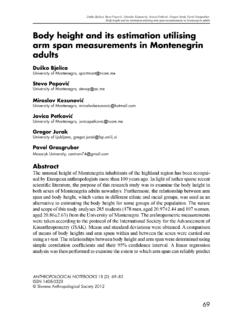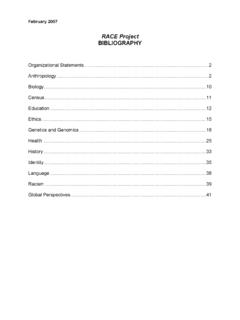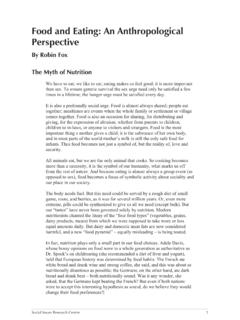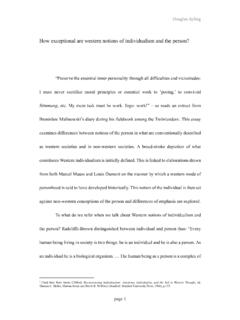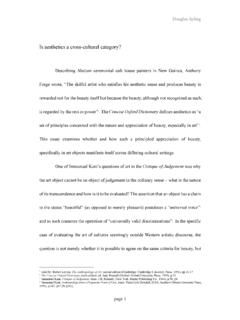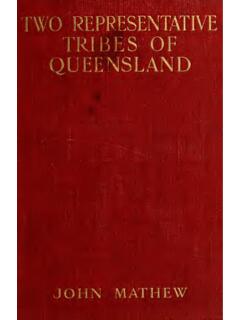Transcription of Introduction: Dance as Social Life and Cultural …
1 5 anthropological NOTEBOOKS 16 (3): 5 1408-032X Slovene anthropological Society 2010 Maru a Pu nik: introduction : Dance as Social life and Cultural PracticeIntroduction: Dance as Social life and Cultural PracticeMaru{a Pu{nikuniversity of Ljubljana, Dance occupies an important place in the Social structure of all human cultures throughout history. Dance is most commonly defined as a way of human expression through movement. But Dance simply cannot be reduced merely to movement. While it is true that movement is indeed a fundamental feature of Dance , because Dance can also be defined as a specific art movement, based on the expressive moves of the human body, Dance is also much more. A number of theoretical definitions of Dance define it as a conscious way of rhythmic movements of the body in a defined bounded space, but these either sport-kinesiological or art theories of Dance usually overlook many symbolic aspects of Dance .}}
2 In many cases, they reduce Dance to its physical component in terms of aesthetically perfected rhythmic physical activity, but they overlook the multiple roles and meanings that Dance has for the society in which it appears. The purpose of this anthropology of Dance issue is to unfold various meanings and nuances of Dance in contemporary societies, with different contri-butors with different examples from around the ( Dance ) world illustrating how Dance can be observed, investigated and theorised in all its the anthropological point of view, Dance can be defined as a Cultural practice and as a Social ritual (Radcliffe-Brown 1994), whereby Dance is seen as a means of aesthetic pleasure and a means for establishing ties and specific structure in the community.
3 Dance as a Social ritual can be considered in the light of the symbolic aspects of a specific culture and in the light of the processes of identification and differentiation through the meanings that it produces for the individuals in this always bears a specific meaning, which depends on the Social setting in which it appears. For example: if in a particular Dance a man turns a woman under his arm, in the literal sense, on the denotative level, this body movement conveys a meaning of a Dance turn. But on the broader Cultural , connotative level, this movement can talk about male domination and female subordination, about chauvinism and macho patriarchal culture. However, in some other cultures, this movement can be a sign of female superi-ority and male servility to a woman, which signifies a matriarchal structure of society.
4 Or to illustrate this with another example, in a certain segment of modern Western societies, women s powerful and enthusiastic movement of hips and buttocks is labelled as obscene, excessive and signifying vulgarity and immorality, but this same movement in some other segments of the same society indicates female confidence and self-esteem and serves as a 6 anthropological Notebooks, XVI/3, 2010sign of female emancipation and gender equality. Moreover, this very same hip and buttocks movement in ceremonial ritual dances of some African tribes can bear only the meaning of worship and glorification of woman s uterus and thus of fertility of female being. Such semantic signification of dances is also the reason that nowadays we often characterize some urban, street dances, which emerge as sub- Cultural Dance styles, as inappropriate or even harmful dances.
5 However, bodily moves, Dance figures or even Dance styles are not indecent or inappropriate by themselves, but such semantic baggage is always put on them by the society in which they , as Sachs (1997) notes, Dance was at all times and in all cultures (from the magic and animism of Palaeolithic man to the indigenous religions of African peoples and tribes; from the ancient civilizations of the East and the ancient societies of medieval Europe to the Western capitalist societies) tightly embedded in the life of a par-ticular society. It was a form of communication and an integral part of the reproduction of the Social system. To paraphrase Bourdieu (1994: 4), I can argue that Dance as a specific language is a socially-historical phenomenon, dependent on the space and time in which it exists and dependent on the power structures that rule in that time.
6 Dance is a learned Cultural practice; Polhemus (1993: 8) says that societies create dances and that Dance is actually a metaphysics of culture , because a culture of specific society is embodied in the forms of material and physical culture, and the latter is also stylized and schematized in the form of this respect, all contributors to this issue study Dance from the broader anthro-pological and Cultural studies perspectives and go beyond narrower conceptualizations of Dance as mere physical movement. The field of Dance studies, from the anthropological perspective, has been growing in recent decades; in this issue, Dance is dealt with as a Cultural practice and a Social life . There is much dancing all around the world.
7 People Dance for fun, pleasure, leisure, for money, for their jobs, for their self-expression, for the sake of tradition, for ritual purposes etc. As such, Dance should be examined as a part of everyday life , whether in Argentina, India, America, England, Jamaica, Senegal, Tanzania, New Zealand, Russia, Turkey, Slovenia or Australia. Beside the presentation of Dance in all these geographical contexts, different questions regarding Dance in contemporary societies are also opened in this issue. Contributors examine Dance as a part of modern world and investigate various dances and Dance -related practices in the context of globalization and some also in the context of the capitalist world her critical essay, Marta E. Savigliano addresses the questions of queer interests in tango and reflects on queer tango in globalised capitalism.
8 She studies tango as an icon of heteronormative love and takes into consideration queer and regular milongas in Buenos Aires to find out how queer tango affects milonga culture and how tango intervenes in the formation of queer Cresswell (2006: 71 73) illustrates this with the case of North American and Latin American dances that entered the British Dance halls in the first four decades of the 20th century ( shimmie, tango). These dances nowadays widely socially accepted were at that time labelled as dances with entirely inappropriate moves, which could impair the morality of British society. In public discourses of that time one could find labels such as degenerated and dirty moves or they were even described as primitive, barbaric, eccentric and dissolute yk Potuo lu-Cook raises issues regarding urban vernacular movement ( Dance and quotidian performance) in globalised Turkey at the edge of Europe and deals with multicultural issues of how difference is embodied and politicised in bodily movement in the gap between Istanbul s Islamic and secular cultures.
9 An investigation of a northern Indian traditional Dance , Kathak, in the globalised world is done by Sarah Morelli. She examines how the traditions of teaching this Dance and the whole philosophy behind it have changed in modern conditions, due to the radi-cal socio-political changes in India as well as due to the transplantation of this Dance to America and its popularisation. A similar case study of the transplantation of the Caribbean dances and culture to the British area is done by Sherrill Dodds, although she makes even a step further when asks a question how the Caribbean migrants in London identify with music and Dance from their Caribbean homeland . These Dance -music practices help them to construct themselves as distinct from a dominant white a similar manner, Maru a Pu nik and Kristina Sicherl investigate the transplan-tation of the global Dance culture, salsa, to the local Slovenian context.
10 Their interest lies in examining salsa Dance as a tool of interpersonal communication and as a global commodified popular culture when exploring the various Social functions that salsa can perform in global, individualised, commercialised and highly competitive contemporary societies. Yet another interesting perspective of contemporary Dance practices is opened by Georgiana Gore. She examines a new Dance genre, flash mob Dance , consisting of a collective Dance event organized in public spaces through mobile phone and internet communication. She argues that such Dance practices experience rapid global spread in consumer capitalism and effectively reconfigure urban spaces and performance sites. Andr e Grau turns to another interesting perspective: the marginalization of figure skating, even in its ice dancing incarnation, inside Dance studies.
